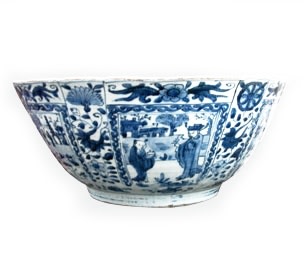Decorated in violet-tinged underglaze blue, the interior and exterior of the steep sides painted to the foliate edge with radiating panels of detailed landscape scenes depicting, alternately, figures in conversation and walking by a fast flowing river with European houses in the background and foreground and ducks on the water, and a boy making an offering to a robed gentleman, the offering different in each version of the scene, each panel surrounded with a border of karakusa scrolls, alternating with and divided by Iznik style tulips and chrysanthemums, the centre repeating the scene seen on the outside panels of a boy offering something to a gentleman, this time on a terrace in which we see dog's-tooth paving, enclosed by a running meander. The bowl supported on a footring, the glazed base with radiating lines.
Literature
A bowl with almost identical decoration is in the Arnhem Museum, and another example can be found in the Victoria & Albert Museum (252-1889) where it is dated 1630-45. See also Maura Rinaldi, Kraak Porcalain (1989) pl.202 p.163 and pl.203 p.164. Using Rinaldi's methods, the features seen on this bowl enable us to date it accurately at c.1635-50. She mentions that we can see contemporaneous Transitional influences in the elaborate, stylized decoration and the adoption of narrative scenes involving figures. For a very similar example see Jorg, Chinese Ceramics in the Collection of the Rijksmuseum, pl.49 p.64 for a bowl, bequest R.E. Duin, where Jorg discusses this bowl and says '...the tulips are typical of this work and may have been derived from European embroidery. The houses too have a non-Chinese appearance, with their symmetrically-placed, divided windows and the straight, triangular roofs. The composition of the central river scene in three horizontal layers is also more Western than Chinese. A Dutch print or drawing may have been sent as a model for these wares though there is no reference to this in the VOC records.' The example in the Rijksmuseum has an almost identical exterior but the centre has a river scene. For a similar large-size Kraak bowl with panels of figures see Oriental Blue and White by Sir Harry Garner (Faber, 1954), illustration 63b, diameter 14.5 ins, in the Victoria and Albert Museum. See also Plate 41, p 109 L?Odyssee de la Porcelaine Chinoise (Collections du Musee National de Ceramique, Sevres, et du Musee National Adrien Dubouche, Limoges, 2003).
Other refs.:
Hartog 1990, pl. 20-22
Avitabile 1992, pl. 53

